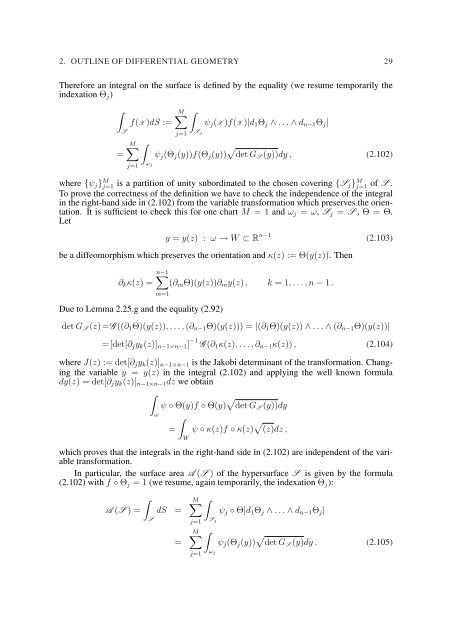EQUATIONS OF ELASTIC HYPERSURFACES
EQUATIONS OF ELASTIC HYPERSURFACES
EQUATIONS OF ELASTIC HYPERSURFACES
You also want an ePaper? Increase the reach of your titles
YUMPU automatically turns print PDFs into web optimized ePapers that Google loves.
2. OUTLINE <strong>OF</strong> DIFFERENTIAL GEOMETRY 29<br />
Therefore an integral on the surface is defined by the equality (we resume temporarily the<br />
indexation Θ j )<br />
∫<br />
=<br />
S<br />
f(X )dS :=<br />
M∑<br />
∫<br />
j=1<br />
M∑<br />
∫<br />
j=1<br />
S j<br />
ψ j (X )f(X )|d 1 Θ j ∧ . . . ∧ d n−1 Θ j |<br />
ω j<br />
ψ j (Θ j (y))f(Θ j (y)) √ det G S (y))dy , (2.102)<br />
where {ψ j } M j=1 is a partition of unity subordinated to the chosen covering {S j } M j=1 of S .<br />
To prove the correctness of the definition we have to check the independence of the integral<br />
in the right-hand side in (2.102) from the variable transformation which preserves the orientation.<br />
It is sufficient to check this for one chart M = 1 and ω j = ω, S j = S , Θ = Θ.<br />
Let<br />
y = y(z) : ω → W ⊂ R n−1 (2.103)<br />
be a diffeomorphism which preserves the orientation and κ(z) := Θ(y(z)). Then<br />
∑n−1<br />
∂ k κ(z) = (∂ m Θ)(y(z))∂ m y(z) , k = 1, . . . , n − 1 .<br />
m=1<br />
Due to Lemma 2.25.g and the equality (2.92)<br />
det G S (z)=G ((∂ 1 Θ)(y(z)), . . . , (∂ n−1 Θ)(y(z))) = |(∂ 1 Θ)(y(z)) ∧ . . . ∧ (∂ n−1 Θ)(y(z))|<br />
=[det[∂ j y k (z)] n−1×n−1 ] −1 G (∂ 1 κ(z), . . . , ∂ n−1 κ(z)) , (2.104)<br />
where J(z) := det[∂ j y k (z)] n−1×n−1 is the Jakobi determinant of the transformation. Changing<br />
the variable y = y(z) in the integral (2.102) and applying the well known formula<br />
dy(z) = det[∂ j y k (z)] n−1×n−1 dz we obtain<br />
∫<br />
ψ ◦ Θ(y)f ◦ Θ(y) √ det G S (y))dy<br />
ω<br />
∫<br />
= ψ ◦ κ(z)f ◦ κ(z) √ (z)dz ,<br />
W<br />
which proves that the integrals in the right-hand side in (2.102) are independent of the variable<br />
transformation.<br />
In particular, the surface area A (S ) of the hypersurface S is given by the formula<br />
(2.102) with f ◦ Θ j = 1 (we resume, again temporarily, the indexation Θ j ):<br />
∫<br />
A (S ) =<br />
S<br />
dS =<br />
=<br />
M∑<br />
∫<br />
ψ j ◦ Θ|d 1 Θ j ∧ . . . ∧ d n−1 Θ j |<br />
S j<br />
M∑<br />
∫<br />
ψ j (Θ j (y)) √ det G S (y)dy . (2.105)<br />
ω j<br />
j=1<br />
j=1

















